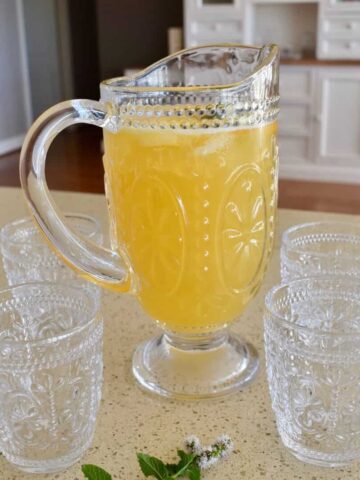Combine pomegranate juice with just three other ingredients and you have the most amazing cordial! Pomegranate cordial is perfect in drinks and cocktails or desserts.

Jump to:
Why make this cordial?
If it's pomegranate season, this recipe is the perfect way to preserve some of this crimson-coloured fruit. (And if you want even more ways to enjoy pomegranate, browse my list of the 20 best ways to enjoy this awesome fruit.)
You can add pomegranate cordial to lemonade for the perfect pink lemonade, pour it over ice cream or use it in my Festive Fruit Cups recipe.
Mocktails and cocktails that call for grenadine might also be nice with this cordial. Pomegranate Cordial Cocktail, anyone?
Or just add water – still or sparkling – for your basic cordial refresher.
What's the difference between Pomegranate Cordial and Grenadine?
Pomegranate Cordial is very similar to grenadine, but a little less sweet. You could substitute it for many recipes requiring grenadine.
An old-fashioned recipe
The recipe I've used here is based on the recipe for Passionfruit Cordial recorded by Nana Ling in the late 1930s.
I've adapted that recipe to to make Lime Cordial, Orange Cordial, Lemon and Mint Cordial and Elderflower Cordial.
Here, though, we're making Pomegranate Cordial.
Ingredient notes

To make this lovely cordial, you'll need:
- pomegranate juice from fresh pomegranates
- caster sugar
- lemon juice
- tartaric acid.
Keep scrolling for ingredient quantities at the end of this post in the recipe card.
How do I juice a pomegranate?
It's easier than you might think! First, cut open the pomegranate and remove the seeds which contain all of that wonderful ruby red juice.

Check out my post, which contains an instructional video, if you're unsure how to do this.
Once you have the seeds, simply whizz them in a blender or food processor and then put them through a sieve to extract the juice.

Can I use citric acid instead of tartaric acid?
You can, however tartaric acid is generally preferred in sweet cordials. In Australia, find stockists of tartaric acid listed on the McKenzie's website.
Keep in mind that while both are used as preservers, tartaric acid has a sharper and more biting sour taste, while citric acid has a refreshing and fruity sour taste.
So the cordial will have a slightly different taste depending on which acid you use.
How to make Pomegranate Cordial
It's a simple process to make this cordial that you'll enjoy for weeks.
Once you've juiced the pomegranate (see above if you need juicing instructions), combine pomegranate juice, lemon juice and sugar in a saucepan.
Stir over low-medium heat to dissolve the sugar. Heat until almost boiling and then take off the heat.
Add tartaric acid and stir through to dissolve.
Allow to cool a little.
Strain using a muslin cloth, before pouring into sterilised bottles and sealing with lids.
Storing your cordial
Your cordial should keep in the fridge for up to a few months.
It could also be bottled for shelf storage, though you will need to rely on your own research and knowledge of bottling and preserving.
More drinks recipes
Some more old-fashioned drinks recipes from the collection:
Made this recipe and love it? Please take a moment to rate the recipe and leave a comment below. It’s such a help to others who want to try the recipe. (And it really makes my day to hear how Nana Ling's recipes are being made, shared and loved all around the world! - Libby x)
For more fun and deliciousness in the kitchen, follow along on Facebook, TikTok and Pinterest, and subscribe for new posts via email.

Pomegranate Cordial Recipe
Ingredients
- 1 ½ cups fresh pomegranate juice
- 2 cups caster sugar
- 1 small lemon (juice only)
- 1 teaspoon tartaric acid
Instructions
- Combine pomegranate juice, lemon juice and sugar in a saucepan.
- Stir over low-medium heat to dissolve sugar. Heat until almost boiling and take off the heat.
- Add tartaric acid and stir through to dissolve.
- Allow to cool a little.
- Strain using muslin cloth, pour into sterilised bottles and seal with lids.
Notes
- To juice a pomegranate, cut open the pomegranate and remove the seeds which contain the juice. Once you have the seeds, simply whizz them in a blender or food processor and then put them through a sieve to extract the juice
- You can use citric acid instead of tartaric acid, but keep in mind that while both are used as preservers, tartaric acid has a sharper and more biting sour taste, while citric acid has a refreshing and fruity sour taste.









Leave a Reply